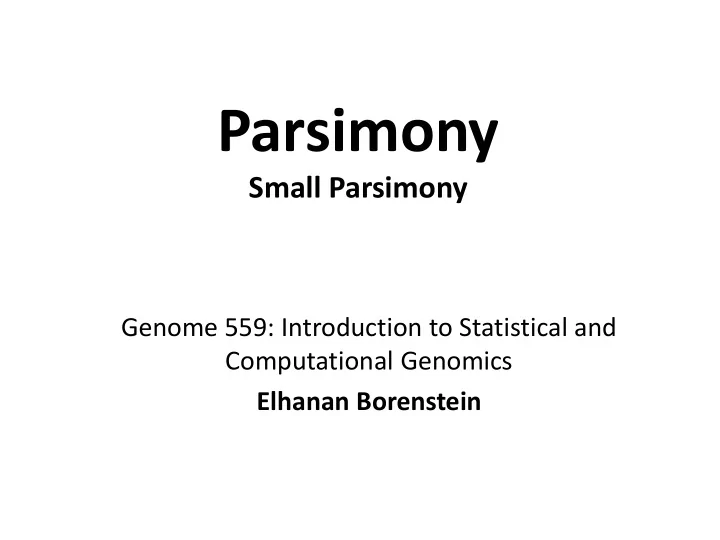

Parsimony Small Parsimony Genome 559: Introduction to Statistical and Computational Genomics Elhanan Borenstein
A quick review The parsimony principle: Find the tree that requires the fewest evolutionary changes! A fundamentally different method: Search rather than reconstruct Parsimony algorithm 1. Construct all possible trees 2. For each site in the alignment and for each tree count the minimal number of changes required 3. Add sites to obtain the total number of changes required for each tree 4. Pick the tree with the lowest score
A quick review The parsimony principle: Find the tree that requires the fewest evolutionary changes! A fundamentally different method: Search rather than reconstruct Parsimony algorithm 1. Construct all possible trees Too many! 2. For each site in the alignment and for each tree count the The small minimal number of changes required parsimony problem 3. Add sites to obtain the total number of changes required for each tree 4. Pick the tree with the lowest score
Large vs. Small Parsimony We divided the problem of finding the most parsimonious tree into two sub-problems: Large parsimony: Find the topology which gives best score Small parsimony : Given a tree topology and the state in all the tips, find the minimal number of changes required Divide and conquer. Think functions !! Large parsimony is “NP - hard” Parsimony Algorithm 1) Construct all possible trees Small parsimony can be solved 2) For each site in the alignment and for each tree count the minimal quickly using Fitch’s algorithm number of changes required 3) Add all sites up to obtain the total number of changes for each tree 4) Pick the tree with the lowest score
The Small Parsimony Problem Input: 1. A tree topology: 2. State assignments for all tips: Human C A C T Chimp T A C T Bonobo A G C C Gorilla A G C A Gibbon G A C T Lemur T A G T human chimp gibbon lemur gorilla bonobo human chimp gibbon lemur gorilla bonobo C T G T A A Output: The minimal number of changes required: parsimony score ( but in fact, we will also find the most parsimonious assignment for all internal nodes )
Fitch’s algorithm Execute independently for each character: Two phases: 1. Bottom-up phase : Determine the set of possible states for each internal node 2. Top-down phase : Pick a state for each internal node 1 2 human chimp gibbon lemur gorilla bonobo C T G T A A
1. Fitch’s algorithm: Bottom-up phase (Determine the set of possible states for each internal node) 1. Initialization: R i = { s i } for all tips 2. Traverse the tree from leaves to root (“post - order”) 3. Determine R i of internal node i with children j , k: if R R R R j k j k R i otherwise R R j k T,A Let s i denote the T state of node i and R i 1 G,T,A the set of possible C,T states of node i G,T human chimp gibbon lemur gorilla bonobo C T G T A A
1. Fitch’s algorithm: Bottom-up phase (Determine the set of possible states for each internal node) 1. Initialization: R i = { s i } for all tips 2. Traverse the tree from leaves to root (“post - order“) 3. Determine R i of internal node i with children j , k: if R R R R j k j k R i otherwise R R j k Parsimony-score = T,A # union operations T 1 G,T,A C,T G,T Parsimony-score = 4 human chimp gibbon lemur gorilla bonobo C T G T A A
2. Fitch’s algorithm: Top -down phase (Pick a state for each internal node) 1. Pick arbitrary state in R root to be the state of the root , s root 2. Traverse the tree from root to leaves (“pre - order”) 3. Determine s i of internal node i with parent j : if s R s j i j s i otherwise arbitrary state R i T,A T 2 G,T,A C,T G,T Parsimony-score = 4 human chimp gibbon lemur gorilla bonobo C T G T A A
2. Fitch’s algorithm: Top -down phase (Pick a state for each internal node) 1. Pick arbitrary state in R root to be the state of the root ,s root 2. Traverse the tree from root to leaves (“pre - order”) 3. Determine s i of internal node i with parent j : if s R s j i j s i otherwise arbitrary state R i A T 2 T T T Parsimony-score = 4 human chimp gibbon lemur gorilla bonobo C T G T A A
And now back to the “big” parsimony problem … How do we find the most parsimonious tree amongst the many possible trees?
Recommend
More recommend